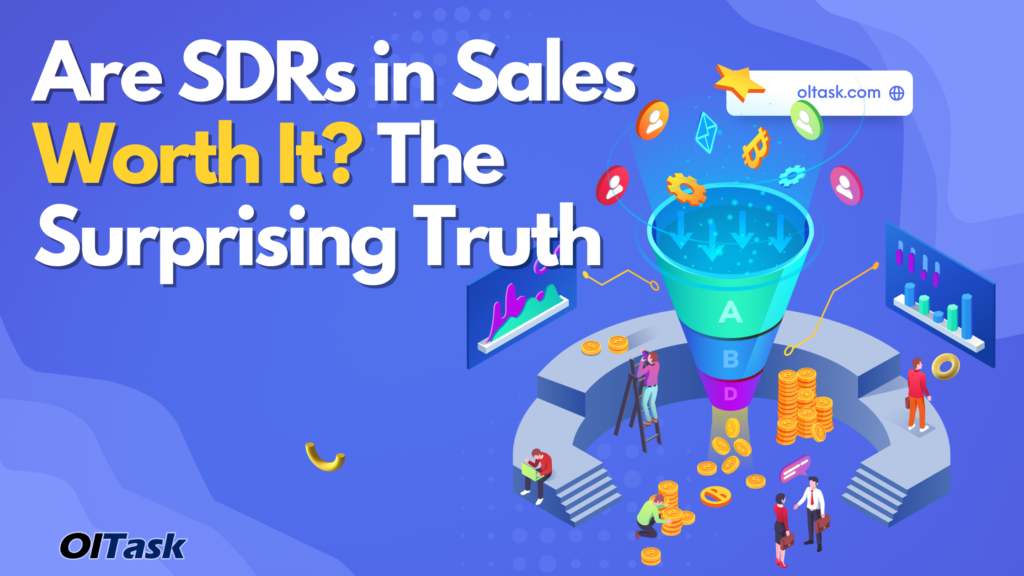Demystifying SDR in Sales: What, Why, and How

The world of sales has evolved, and at its forefront stands the Sales Development Representative (SDR), a pivotal role in bridging the gap between marketing and sales teams.
As businesses strive to thrive in the competitive e-commerce landscape, understanding what SDRs are, why they matter, and how to harness their potential becomes crucial.
In this article, we delve deep into the essence of SDRs, equipping you with actionable insights that empower your outbound sales strategy and resonate with your target audience.
What is an SDR (Sales Development Representative)?

SDRs form the bedrock of prosperous outbound sales. They are the initial bridge connecting your business and potential customers. Their tasks include:
- Identifying and Researching Leads: SDRs meticulously examine leads, gauging their suitability for your offerings.
- Qualifying Leads: They assess if leads align with your ideal customer profile, enabling you to focus on promising prospects.
- Setting the Stage for Sales: SDRs pave the way for effective sales by filtering out unfit leads. This ensures your sales team concentrates on valuable opportunities.
- Optimizing Efficiency: By distinguishing high-potential leads, SDRs enhance your team’s efficiency, directing efforts toward conversions.
SDRs function as sales gatekeepers, streamlining outreach and boosting meaningful connections. Their role is pivotal in transforming prospects into conversions by engaging effectively and connecting your business with those most likely to convert.
Why do SDRs Matter in Business Growth?
SDRs are your front-line champions for revenue growth. Their significance lies in several key aspects
- Nurturing Leads: SDRs carefully nurture relationships with potential customers, guiding them from curiosity to genuine interest, transforming them into promising opportunities.
- Shortening Sales Cycle: By reaching out to prospects at an early stage, SDRs accelerate the sales process. This timely engagement leads to faster decision-making and swifter conversions.
- Identifying Market Trends: SDRs act as your eyes and ears on the ground. Their interactions provide invaluable insights into customer preferences and pain points, helping you adapt your strategies and offerings.
In a world where customer attention spans are limited, SDRs play an integral role in capturing interest swiftly, guiding leads towards conversions, and equipping your business with essential market intelligence.
Key Components of a High-Performing SDR Team

Crafting a high-performing SDR team involves a blend of strategic components that contribute to their success. These elements form the bedrock of a well-rounded SDR team.
- Recruitment: Selecting the right individuals is crucial. Look for candidates with strong communication skills – both verbal and written. Additionally, seek out those who possess a tenacious attitude and the drive to overcome challenges. The ability to listen actively and empathize with leads is equally vital.
- Training: Equipping your SDRs with the right tools is essential. Provide comprehensive training that covers not only your products or services but also the industry landscape. Arm them with negotiation techniques and objection-handling skills to navigate conversations effectively.
- Metrics and KPIs: Defining and monitoring key metrics is central to measuring success. Establish clear Key Performance Indicators (KPIs) like response rates, conversion rates, and pipeline contribution. Regularly track these metrics to evaluate performance, identify areas for improvement, and optimize your team’s strategies.
By ensuring that your SDR team is composed of the right people, equipped with the necessary skills, and driven by measurable goals, you create a foundation for consistent excellence. These components work synergistically to enhance your SDR team’s ability to engage leads effectively, nurture relationships, and contribute significantly to revenue generation.
How Can You Implement Strategies for Successful SDR Outreach?
Effective outreach strategies are pivotal for SDR success. Here’s how you can implement tactics to optimize your outreach efforts.
- Personalization: Craft messages tailored to resonate with your target audience’s pain points and needs. Address their specific challenges to establish a genuine connection.
- Multi-channel Approach: Engage leads across diverse channels to maximize your reach. Utilize a mix of emails, social media platforms, and phone calls to meet your leads where they are most active.
- A/B Testing: Experiment with different outreach approaches to identify what resonates best with your audience. Test various subject lines, messaging tones, and call-to-action strategies to refine your approach.
By implementing these strategies, you enhance your SDR team’s ability to engage leads effectively, nurture relationships, and drive meaningful conversions.
Tips for SDR and Marketing Team Collaborations
A harmonious partnership between SDRs and marketing teams is vital for driving successful sales outcomes.
- Sharing Insights and Data: Establish a seamless information flow between SDRs and marketing teams. This ensures that both parties are armed with valuable data and insights. Marketing’s understanding of customer profiles and pain points can help SDRs tailor their approach, while SDRs’ real-world interactions offer invaluable feedback for refining marketing strategies.
- Aligned Messaging: Maintain consistent messaging across all touchpoints. When prospects experience a cohesive message throughout their journey, it creates a more seamless and trustworthy customer experience. SDRs and marketing teams should collaborate to ensure the tone, language, and value proposition remain consistent.
- Efficient Feedback Loop: Encourage a feedback loop where SDRs share insights about lead interactions. This information helps marketing teams refine their collateral, ensuring that materials are relevant and effective in capturing leads’ attention.
By fostering collaboration between SDRs and marketing, businesses establish a unified front that effectively guides leads through the buyer’s journey. The synergy between these teams enhances lead quality, accelerates conversions, and boosts overall revenue generation.
How SDRs can Maximize Technology

Harnessing technology empowers your SDR team to operate efficiently and effectively.
- CRM Systems: Centralize lead management using Customer Relationship Management (CRM) systems. These tools enable you to organize leads, track interactions, and maintain a comprehensive view of your sales pipeline. This organized approach enhances team coordination and ensures no lead falls through the cracks.
- Automation Tools: Streamline repetitive tasks with automation tools. These tools handle routine follow-ups, ensuring timely communication and reducing the chance of leads going cold. This not only optimizes your SDRs’ time but also maintains consistent engagement with prospects.
- Analytics: Data-driven decisions fuel success. Utilize analytics to gain insights into your SDR team’s performance. Track metrics like response rates and conversion rates to identify areas of strength and opportunities for improvement. These insights guide strategic adjustments and refinement.
By integrating technology, you equip your SDR team with tools that enhance their productivity, maintain consistent engagement, and make informed decisions based on real-time data. This empowers your team to achieve higher levels of efficiency, ultimately driving increased revenue growth.
How to Measure SDR Success
The effectiveness of your SDR team can be gauged through crucial metrics that illuminate their impact.
- Conversion Rates: Conversion rates shed light on the effectiveness of your SDR team’s efforts. This metric measures how successfully leads move from initial contact to becoming qualified opportunities. A higher conversion rate signifies that your SDRs are engaging effectively and connecting with leads that have genuine potential.
- Response and Engagement Rates: These metrics evaluate the resonance of your outreach strategies. Response rates indicate the percentage of leads that respond to your outreach, demonstrating the appeal of your messaging. Engagement rates measure how actively leads interact with your communications, reflecting the level of interest you’re able to generate.
- Pipeline Contribution: Assess the impact of your SDRs on your revenue generation process. By measuring the number of qualified opportunities they usher into your sales pipeline, you gain insights into their contribution to your business growth.
These metrics provide tangible insights into the effectiveness of your SDR team’s strategies. By regularly monitoring these metrics, you can identify areas of strength, pinpoint areas for improvement, and optimize your team’s approach to maximize revenue generation.
Challenges and Solutions for SDR Teams
SDR teams often encounter challenges on their path to success. Here’s how to address common hurdles and ensure efficiency in their role, with OlTask’s expertise as SDRs in Sales.
- Overcoming Objections and Rejection: Equip your SDRs with effective objection-handling strategies. This enables them to address concerns tactfully, transforming objections into opportunities for meaningful conversations. Encouraging resilience helps them maintain motivation despite facing rejection, which is a natural part of the outreach process.
- Lead Quality vs. Quantity: Striking the right balance between lead quantity and quality is crucial. While generating leads is important, focusing on those aligned with your ideal customer profile ensures that your SDRs invest time where it matters most. This approach enhances conversion potential and optimizes team efforts.
- Aligning with Sales: Smooth lead transition from SDRs to the sales team is pivotal. Ensure that insights and information gathered by SDRs are seamlessly transferred. Establishing a clear process for lead handoff avoids miscommunication and ensures that the sales team is well-prepared to continue nurturing leads effectively.
By addressing these challenges head-on and implementing effective solutions, your SDR team is better poised to excel in their role, driving successful outbound sales outcomes. Empowering them with objection-handling techniques, emphasizing lead quality, and establishing streamlined communication with the sales team contributes to a cohesive and fruitful approach.
Empower Your Sales Growth
As you embark on the journey to optimize your outbound sales strategy, remember that SDRs are pivotal for success. Their ability to elevate revenue generation efforts and empower business growth is substantial. By implementing the strategies discussed in this article, you tap into their potential.
How OlTask can help: If you’re ready to take the next step and amplify revenue with an efficient SDR team, the experts at OlTask are here to guide you. Reach out today and let’s elevate your sales strategy together, with OlTask as your trusted partner in driving exceptional revenue growth.